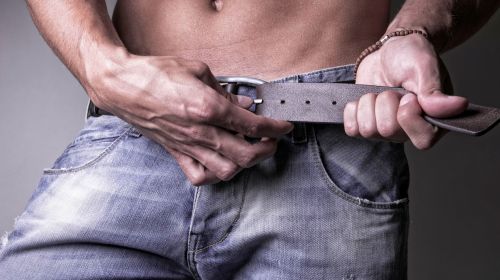The circumcision of the foreskin is part of a ceremony in some religious communities. But there are also medical reasons that make the procedure necessary.
- A circumcision of the foreskin can be used as a therapeutic method, for example, when the foreskin is narrowed in babies and young children.
- © iStock.com/LeventKonuk
Circumcision of the foreskin (circumcision) is done for a number of reasons. In Germany, the operation is performed primarily for medical, hygienic or cosmetic reasons.
In Judaism, circumcision is part of a religious ceremony in boys on the eighth day after birth. In Islam, however, male adolescents are traditionally circumcised by the age of 14 at the latest. It is estimated that around 20 to 40 percent of men worldwide are circumcised; in Germany it is assumed that the incidence is around 15 percent.
Article content at a glance:
When it is medically necessary to circumcise the foreskin
A circumcision of the foreskin can be carried out on personal request, but the costs (around 300 euros) are only covered by statutory health insurance if the treatment is medically necessary. This is the case when recurrent inflammation of the limb and glans (balanitis) causes problems or there is a narrowing of the foreskin.
This narrowing of the foreskin is quite common in male infants. Until around the age of three, the foreskin and glans are naturally glued together. Gradually, this bond loosens as the sexual organ matures. The phimosis should have resolved around the age of five, but no later than the onset of puberty. However, foreskin constriction can also occur in adulthood and cause discomfort.
Circumcision may be medically appropriate in these cases:
The foreskin cannot or only partially be withdrawn during an erection
Pain during an erection
The urine stream is weakened or twisted when urinating
When you urinate, a "balloon" forms on the foreskin
The bladder cannot be emptied (urinary retention)
After the foreskin has been pulled back, a ring, also called a Spanish collar, forms, which constricts the glans (paraphimosis)
Different ways of circumcision
The circumcision of the foreskin is usually performed as an outpatient procedure in a urological practice or in a hospital. In preparation, laboratory tests can be used to determine whether the blood clotting of a boy or man is disturbed. In some cases, an electrocardiogram (EKG) must be carried out to determine whether there are any cardiac diseases that could result in increased risks during surgery.
There are different methods of removing the foreskin, surgical circumcision and the plastibell method.
In surgical circumcision, the foreskin is surgically removed under local or general anesthesia. Only the front part of the foreskin can be removed (plastic circumcision) or the entire foreskin (radical circumcision). With a complete foreskin removal, the skin of the penile shaft is then sewn on below the glans with self-dissolving sutures.
Circumcision without a cut: the plastibell method
The plastibell method is mainly used in children who suffer from a narrowing of the foreskin (phimosis). The foreskin is tied off with the help of a plastic bell. The tissue of the foreskin dies and comes off by itself after about eight to ten days.
Foreskin stretching as an alternative
Foreskin constrictions are very common in infants and toddlers. Circumcision is only necessary in half of the cases. Often the foreskin can be stretched in the further course of development by carefully pushing it back, sometimes with the help of special creams, until it can be pushed back completely. Another alternative is extension plastic. The foreskin is incised lengthways and sutured again. If there are problems with the foreskin ligament, it can be cut and sewn back on.
What to look for after circumcision
After circumcision surgery, wound healing can be accelerated by disinfecting hip baths. You should also pay attention to possible complaints such as redness and swelling and have them checked by a doctor if necessary. You should not shower again until three days after the procedure. Bathing is recommended only after the threads have loosened, which is usually eight to ten days.
The penis is usually healed about two weeks after a circumcision. Nevertheless, it is advisable for men to refrain from sexual intercourse for the first three weeks and then to be very careful with the first sexual activities.
Complications and Side Effects of Circumcision
Complications during and after circumcision are very rare. Mild pain after circumcision is possible but can be treated well with pain relievers. Sometimes there is redness and swelling.
Occasional bleeding occurs, rarely does the formation of irregular wound edges occur. Occasionally, surgical errors lead to infections, urethral constrictions, urethral fistulas or injuries to the glans.
Boys and men should note that the glans are very sensitive at the beginning after circumcision. The sensitive skin of the penis tip, which was previously hidden under the foreskin, is now permanently exposed, and even contact with underwear can cause pain.
Health Benefits of Circumcision
Since the cleaning of the limb after circumcision is made easier, inflammation of the glans penis and urethra can be avoided more easily. In addition, at least the statistical risk of contracting sexually transmitted diseases decreases if the penis is circumcised. This applies to genital herpes, genital warts and gonorrhea, for example.
A few years ago the World Health Organization (WHO) included circumcision of the foreskin as part of its preventive measures against HIV. According to various studies, circumcision reduces the risk of HIV infection for men during unprotected vaginal intercourse by around 40 to 50 percent.
This WHO recommendation is often used as an argument in favor of circumcision. "But this recommendation only applies to 14 African countries in which the number of HIV infections has not reached a level comparable to that in Europe and in which the hygienic conditions are completely different," confirms Wolfgang Bühmann, spokesman for the professional association of German urologists in the Lifeline- Interview and adds: "In some African countries 75 percent of sexually mature women are infected with HIV. It should be noted that circumcision does not protect against HIV infection and other sexually transmitted diseases, it can only reduce the statistical risk of infection. Therefore Nor are they a substitute for protected sex to prevent HIV infection.
Whether circumcision reduces the risk of prostate cancer, penile cancer or the risk of transmission of human papillomavirus to the partner has not yet been clearly confirmed – despite some studies.
Sex is better with a foreskin
Many men have the penis surgically removed because they hope to achieve even more sensitivity and excitability in the limb, i.e. to increase their sensation of pleasure. Belgian researchers have refuted this widespread assumption. To this end, the urologists from the University of Ghent asked around 1,000 circumcised and 300 uncircumcised men. The subjects completed a questionnaire on which they gave detailed information about the irritability of the individual areas of their penis and the intensity of the orgasm.
The result: uncircumcised men had more fun having sex. They achieved higher values on the scale for the touch of the penis shaft and glans as well as for the intensity of orgasm. In addition, it was found that circumcised men were more likely to have symptoms such as pain and numbness in this area.



